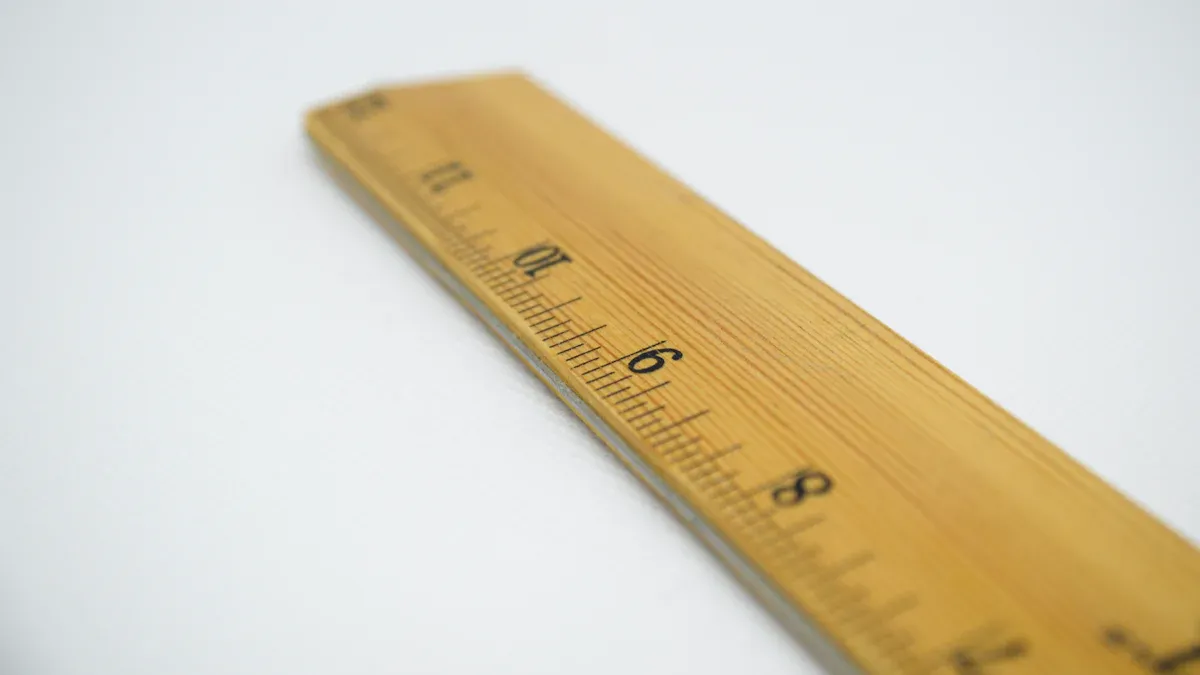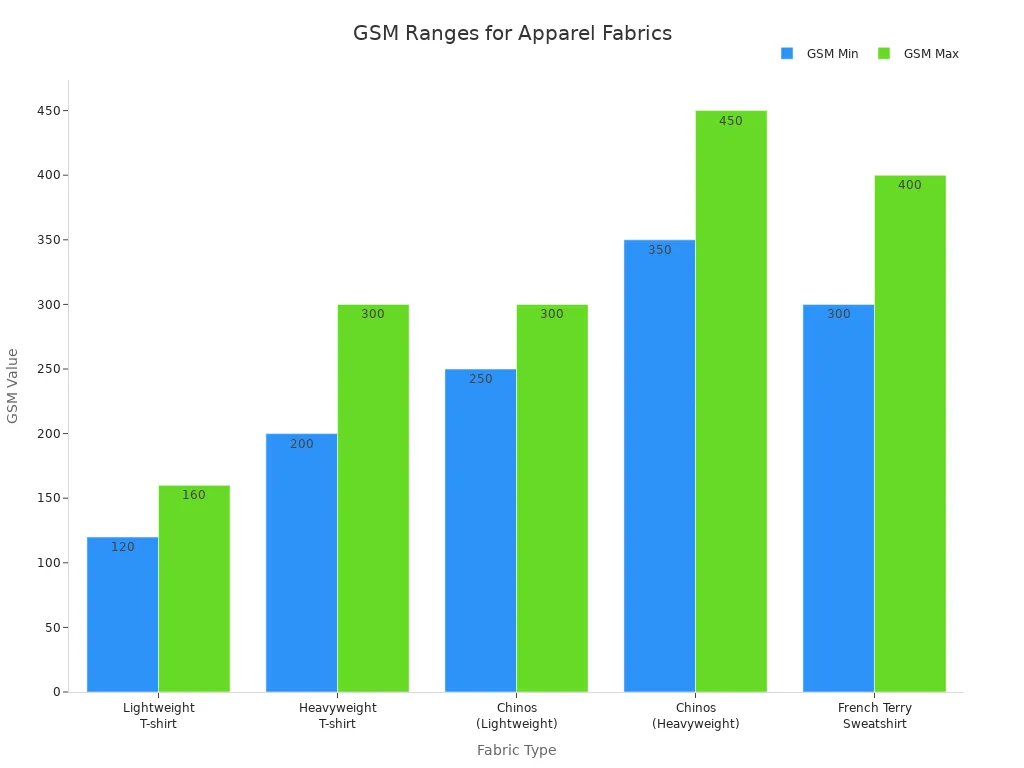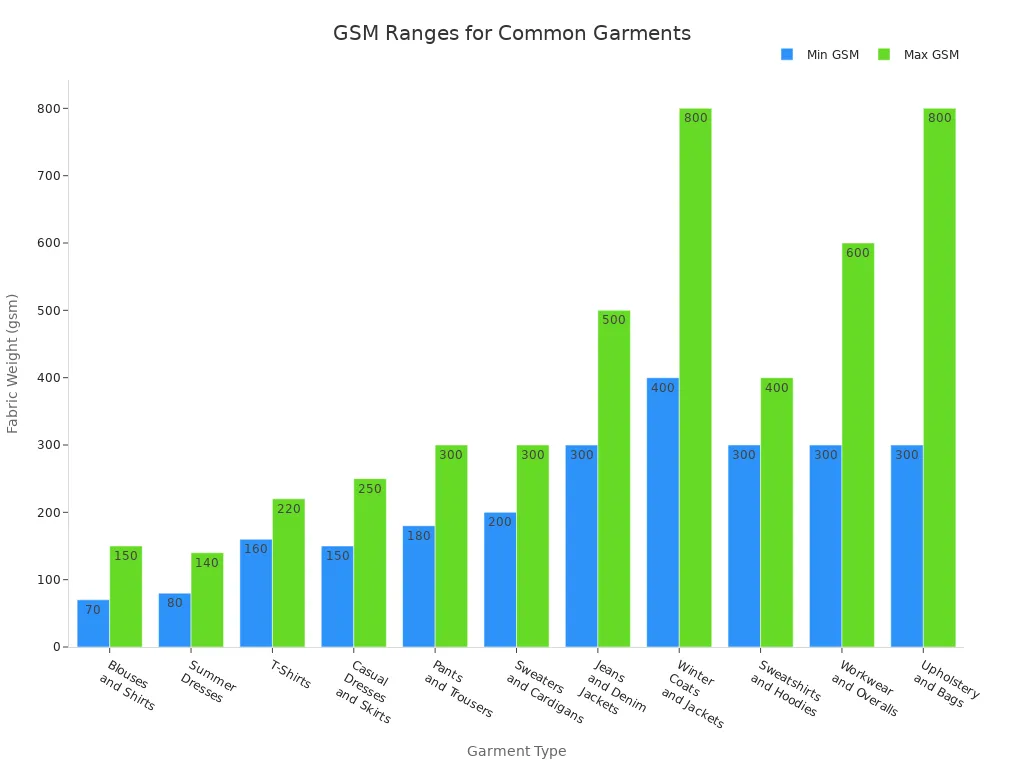Imagine you walk into a clothing store and see labels with numbers like 120 GSM or 250 GSM. You want to pick the best fabric for comfort and durability, but the numbers seem confusing. Many shoppers feel the same way.
56% of shoppers report confusion when reading clothing care labels.
GSM stands for grams per square meter. This number helps you understand how thick or heavy a fabric feels. Learning about differences in GSM can help you choose clothing that fits your climate and activity needs.
GSM stands for grams per square meter. It helps you understand fabric thickness and weight.
Choose lightweight fabrics (100-150 GSM) for summer and heavier fabrics (200+ GSM) for winter to stay comfortable.
Always check both GSM and fabric quality factors like weave and fiber type for the best clothing choices.
You can measure GSM at home by weighing a 10 cm square of fabric and multiplying by 100.
Use GSM as a guide when shopping, but trust your senses to feel the fabric's quality.

You often see the term gsm when shopping for clothes. GSM stands for grams per square meter. This measurement tells you how much a square meter of fabric weighs. You can use gsm to compare the thickness and density of different materials.
To find the gsm of a fabric, follow these steps:
Weigh a sample of the fabric in grams.
Measure the area of the sample in square meters.
Divide the weight by the area to get the gsm.
GSM helps you understand fabric weight. For example, cotton shirts usually have a gsm between 100 and 200. Polyester and wool also use gsm to show how heavy or light the fabric feels. You can use gsm to check if a fabric is suitable for summer or winter.
GSM is a key factor in textile production. It helps manufacturers keep fabric quality consistent. When you know the gsm, you can judge how strong, soft, or thick a fabric will be.
GSM affects your comfort, the durability of your clothes, and how well they fit your needs.
Lighter gsm fabrics (like 50–100 gsm) work best for summer clothing and light scarves.
Medium-weight fabrics (100–200 gsm) are great for shirts, t-shirts, and everyday wear.
Heavier gsm fabrics (200+ gsm) are used for sweatshirts, winter coats, and thick blankets.
Fabric Type | Typical Uses | |
|---|---|---|
50–100 | Lightweight fabrics | Summer clothing, light scarves |
100–200 | Medium-weight fabrics | Shirts, t-shirts, bed linens |
200–300 | Heavier medium-weight | Sweatshirts, casual pants, blankets |
300+ | Heavy fabrics | Winter coats, upholstery |
You want your clothes to last. Higher gsm means the fabric is more durable and resists wear and tear. This is important for items you wash often, like cotton t-shirts or sweatshirts.
GSM also affects comfort. Lighter fabrics feel cool and breathable, while heavier ones keep you warm. You can match gsm to your climate and activity.
Remember, gsm is only one part of fabric quality. You should also look at weave, fiber type, and finish to make the best choice.
Understanding the differences in gsm helps you make better clothing choices. You can compare fabrics by looking at their gsm, thickness, and weave. Each factor changes how the fabric feels and works for different uses.
You often see lightweight and heavyweight fabrics in stores. The differences in gsm between these types affect how you feel when you wear them.
Lightweight fabrics usually have a gsm under 150. These fabrics feel soft, airy, and cool. You find them in summer shirts, dresses, and activewear.
Heavyweight fabrics have a gsm over 350. These fabrics feel thick, sturdy, and warm. You see them in winter coats, sweatshirts, and heavy pants.
Here is a quick look at typical gsm values for common clothing items:
Fabric Type | GSM Range |
|---|---|
Lightweight T-shirt | 120-160 |
Heavyweight T-shirt | 200-300 |
Chinos (Lightweight) | 250-300 |
Chinos (Heavyweight) | 350-450 |
French Terry Sweatshirt | 300-400 |

Light gsm fabrics let air move through the weave. This makes them breathable and sweat-wicking. You stay cool and dry in hot weather or during exercise. Linen (80-120 gsm), cotton voile (70-100 gsm), and cotton lawn (90-120 gsm) are great examples. Heavy gsm fabrics keep you warm and protect you from cold air. They work best for winter or when you need extra insulation.
Tip: Choose light gsm fabrics for summer and heavy gsm fabrics for winter. This simple rule helps you stay comfortable all year.
You might think that a thicker fabric always means a higher gsm, but this is not always true. The differences in gsm come from more than just thickness.
GSM measures the weight of a fabric over a set area.
Thickness is the physical depth of the fabric, measured in millimeters.
A thick fabric can have a low gsm if it has a loose weave or uses light fibers.
A thin fabric can have a high gsm if it is tightly woven or uses dense fibers.
Manufacturers measure thickness in millimeters or mils. They test gsm during production and report it to buyers. Sometimes, two fabrics with the same gsm feel very different because of their thickness or fiber type. You need to check both gsm and thickness to understand how a fabric will perform.
Note: Always look at both gsm and thickness when you want to compare fabrics. This helps you avoid surprises when you buy clothes online or in stores.
The weave of a fabric changes its gsm. The differences in gsm often come from how tightly the threads are woven together.
Tighter weaves, like twill and interlock, use more material in the same space. This leads to a higher gsm and a denser, warmer fabric.
Looser weaves, such as chiffon and voile, use less material. This results in a lower gsm and a lighter, more breathable fabric.
Here is a table showing how weave and gsm work together for different uses:
Fabric Weight | GSM Range | Best For |
|---|---|---|
Lightweight | 100–150 GSM | Hot climates or layering |
Medium-weight | 150–200 GSM | Everyday wear in moderate climates |
Heavyweight | 200+ GSM | Cooler weather or structured wear |
You can see that the differences in gsm help you pick the right fabric for your needs. A higher gsm often means a tighter weave and more warmth, while a lower gsm means more airflow and comfort in heat.
Remember: The differences in gsm, thickness, and weave all work together. You get the best results when you check all three before making a clothing decision.
When you shop for clothes, you often see gsm or fabric weight listed on tags. These numbers help you compare the thickness and quality of different fabrics. You should know that not all labels are accurate. Consumer groups have found that about 41% of garment labels do not match the real fiber content. This happens most with cotton-polyester blends. Some labels show more cotton than the fabric really has. This can make you think you are buying a higher quality or more eco-friendly item than you are. Always check the feel and look of the fabric, not just the label.
Tip: Use gsm as a guide, but trust your senses and look for extra details about fabric weight and quality.
You can measure gsm at home if you want to know the real fabric weight. Here is a simple way to do it:
Cut a square of fabric that measures 10 cm by 10 cm.
Weigh the square in grams using a kitchen scale.
Multiply the weight by 100 to get the gsm.
For example, if your fabric square weighs 2 grams, the gsm is 200. This method helps you check the typical gsm of a t-shirt or any other garment. You can use this to compare fabric weight and quality at home.
A fabric weight chart helps you see the typical gsm ranges for common clothing. This makes it easy to pick the right fabric for your needs.
Garment Type | Fabric Weight (gsm) | Common Fabrics |
|---|---|---|
Blouses and Shirts | 70-150 | Cotton lawn, Voile, Silk, Rayon, Lightweight Jersey |
Summer Dresses | 80-140 | Silk Chiffon, Georgette, Lawn, Voile |
T-Shirts | 160-220 | Cotton Jersey, Rayon Jersey, Polyester Blends |
Casual Dresses and Skirts | 150-250 | Cotton, Linen, Rayon, Mediumweight Jersey |
Pants and Trousers | 180-300 | Twill, Chino, Linen |
Sweaters and Cardigans | 200-300 | Wool, Cashmere, Medium-weight knit fabric |
Jeans and Denim Jackets | 300-500 | Denim |
Winter Coats and Jackets | 400-800 | Wool, Heavy Tweed, Heavy Canvas |
Sweatshirts and Hoodies | 300-400 | Fleece, Heavy Jersey, Sweatshirt Fleece |
Workwear and Overalls | 300-600 | Cotton Canvas, Duck Cloth, Heavy Twill |
Upholstery and Bags | 300-800 | Heavy canvas, leather |

You can use this fabric weight chart to match fabric weight to your climate and activity. For example, the typical gsm of a t-shirt is 160-220. Lighter weights work for summer, while heavier weights give more warmth and durability. This chart helps you choose the right quality and fabric for every season.

You make better clothing choices when you match fabric weight to your climate and daily activities. In hot, humid places, you want to stay cool and dry. Lightweight cotton or linen fabrics with a gsm between 100 and 150 work best. These fabrics let air flow and wick away sweat, keeping you comfortable. In cold, dry climates, you need heavier garments. Choose fabric weight above 200 gsm to trap warmth and protect you from chilly air.
Climate Type | Recommended GSM Range |
|---|---|
Hot, Humid | |
Cold, Dry | 200+ GSM (heavier garments) |
Your activity level also affects your ideal fabric weight. If you play sports or exercise, you need clothing that helps you move and keeps you cool. Lightweight, breathable fabrics work best for high-intensity or low-contact sports. For contact sports or cold-weather activities, heavier fabrics provide more protection and warmth.
Activity Level | Recommended GSM Characteristics |
|---|---|
High-intensity/low-contact sports | |
Contact sports | Heavier, insulating options for protection and warmth |
Cold-weather environments | Heavier fabrics to provide insulation and comfort |
You can use these tables to guide your choices. For example, if you shop for a t-shirt for summer, look for a cotton fabric weight comparison in the 120–150 gsm range. Everyday t-shirts often fall in this range, giving you comfort and breathability.
Tip: Always check the gsm and fabric weight on the label. This helps you pick the right clothing for your climate and activity.
You might think that a higher gsm always means better quality, but this is not true. GSM tells you about fabric weight, but it does not show the whole picture. To judge quality, you need to look at other factors.
Fiber content: Cotton, linen, and blends all feel different and wear differently.
Weave: The way threads cross each other changes how the fabric feels and lasts.
Finish: Some fabrics get special treatments to make them softer or more durable.
Fabric grain: This affects how your clothes hang and move.
Fabric type: Each type has its own strengths and weaknesses.
Print quality: Good prints last longer and look better.
Fabric texture: Softness and smoothness matter for comfort.
Color vibrancy and retention: High-quality fabrics keep their color after washing.
When you compare cotton fabric weight, check the weave and fiber content. A tightly woven cotton shirt with a medium gsm often feels softer and lasts longer than a loosely woven one with the same gsm. Always feel the fabric and look at the details before you buy.
Note: GSM helps you compare fabric weight, but you should always check other signs of quality. This gives you the best value for your money.
Many people believe that thicker fabric always means a higher gsm. This is not always true. GSM has a direct link to fabric thickness, but other things matter too. The weaving method and the fineness of the yarns also change how thick a fabric feels. You might find a thick fabric with a low gsm if it uses loose weaves or light fibers. A thin but dense fabric can have a high gsm because of tight weaving or heavy fibers.
Durability depends on fiber quality and the weaving or knitting process, not just on high gsm.
Cotton fabric weight comparison shows that two shirts can have the same gsm but feel very different because of weave or fiber type.
Some people think that a heavy t-shirt always lasts longer. In reality, the quality of the cotton and the way the fabric is made matter just as much.
Remember: Always check gsm, fabric weight, weave, and fiber content. This helps you avoid common mistakes and pick the best clothing for your needs.
When you choose clothing, GSM gives you a clear way to compare fabric weight and comfort. Keep these key points in mind:
Always consider both GSM and fabric composition.
Match GSM to your climate: lightweight (100–150 GSM) for hot weather, mid-weight (150–200 GSM) for mild days, and heavy (200+ GSM) for cold.
Look at weave, fiber quality, and finishes for the best results.
You can use GSM knowledge in practical ways:
Ask store staff if GSM is not listed.
Remember your favorite GSM range for comfort.
Compare fabric weights in-store when possible.
Next time you shop, use GSM as a guide and explore different fabrics to find what feels best for you.
GSM stands for grams per square meter. This number tells you how much one square meter of fabric weighs. You can use GSM to compare the thickness and heaviness of different fabrics.
No, a higher GSM only means the fabric is heavier. Quality depends on fiber type, weave, and finish. You should check these details along with GSM for the best results.
You can cut a 10 cm x 10 cm square from the fabric, weigh it in grams, and multiply by 100. This gives you the GSM. Use a kitchen scale for accuracy.
Lightweight fabrics with 100–150 GSM work best for summer. These fabrics feel cool and let air move through. Cotton and linen are good choices for hot weather.
Yes! The weave, fiber, and finish change how a fabric feels. Two fabrics with the same GSM can feel soft or rough, thick or thin. Always touch and compare before you buy.